A couple weeks or so I wrote about female super-heroes and the way that the major properties of the big two are justly not as popular as, say, Sailor Moon. In particular, I talked a little about Wonder Woman, and how she was just not necessarily what girls were looking for in a pulp genre, and for good reason.
I was thinking about that a little more and (er) wondering if I’d overstated the case. After all, the Lynda Carter TV series was quite popular back in the day, wasn’t it? Admittedly, compared to Superman or Batman or Spiderman or…well, lots of properties, really, WW hasn’t had a ton of multi-meida success — one three-season TV series is fairly small beer as these things go (I guess she did have an animated series, but it didn’t really go anywhere, I don’t think. And there’s a movie in development hell….)
Anyway, then Dirk posted a link to this strip and article about how the original Wonder Woman creator, Charles Moulton (real name William Moulton Marston, apparently), struggled with censorship — it seems he wanted to constantly tie the character up in chains, and editorial felt he needed to find other materials with which to truss up his Amazon. (No, really.) That article is by Dr. K, who also included a strip showing our heroine in a gimp mask.
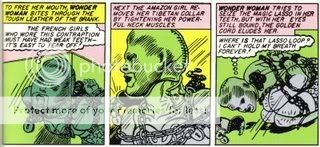
©DC Comics, Charles Moulton, and Harry G. Peter in some combination.
Dirk commented that Wonder Woman was probably DC’s most problematic character.”
So now I was kind of intrigued. I’d known that Moulton was…um, idiosyncratic, but I’d never read a ton of his stuff. So I turned to trusty Amazon in the hopes that they had one of those cheap black and white showcase book of his early strips. No dice, unfortunately; the only thing available is one of the hardback golden age treasuries for 50 bucks, and I’m not that interested. They did have a volume of “The Greatest Wonder Woman Stories Ever Told” though. Not too pricey, and I figured I could read some Moulton and see what other writers had done with the character over the years.
There were only two Charles Moulton stories as it turned out, with art by Harry G. Peter. The first is what I think must be Wonder Woman’s first appearance (there is no historical notation to speak of — nice job, DC) and it’s more or less unreadable. It starts in media res, after Wonder Woman saved Steve Trevor and he calls her beautiful and so she falls in love with him. Then she window shops (cause that’s what woman do) in her underwear (because that’s what super-heroes do) while men stare at her and women make jealous quips. Then she enters into a business deal to go on the stage performing her bullets-and-bracelets wheeze. Unfortunately, the deal is made with an unpleasant Jewish caricature who has a big nose and is money-grubbing, so he rips her off, but she’s Wonder Woman! So she beats up the Jew and then later beats up what I presume are Nazis (the script is not especially clear) — thus bashing anti-semite and Jew alike, which is kind of nice message of peace and equality, I guess. She saves Steve again too, in there.
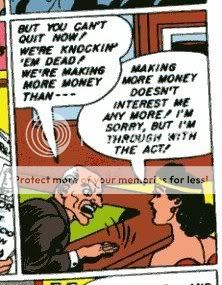
©Charles Moulton, Harry G. Peter, DC Comics
Oh, yeah, and there’s a totally bizarre sequence where she pays a nurse to switch places with her so the nurse can go off to be with her husband and WW can be the caretaker for the bedridden Steve Trevor. The nurse’s name is Diana Prince, of course, which is a coincidence, because WW’s name is also Diana! How about that! And that’s how WW gets her secret identity — in aphasiac, passive-agressive pursuit of the man she loves because he threw her a casual compliment. Empowerment aplenty here, ladies!
So not an especially auspicious beginning — and you’ve got to be thinking, if these are the greatest wonder woman stories, what in god’s name do the worst ones look like? Luckily, the second story in the collection is more like it. This is from 1948, and in the intervening six years Moulton and Peter have managed to figure out more clearly what they were doing. Specifically, there’s a lot less mooning around after Steve Trevor and a lot more girls being tied up and dominated. Also, the plot has moved from merely being annoyingly vague and scattershot into a sublime realm of utter nonsense. Evil women from Saturn; Venus Girdles which force the wearer to be loving and obedient; WW’s entire rogues gallery, including Giganta, a gorilla who has been turned into a woman (or as she introduces herself, “I’m Giganta, formerly a female gorilla!); WW’s side-kicks, the Holiday Girls, transformed into gorillas from the neck down; Hypnota controlling the will of unsuspecting typists; Etta Candy, WW’s fat sidekick, shouting “Woo-woo! This is as easy as cutting chocolate fudge!”
Also, did I mention all the girls being tied up and dominated? What with Hypnota, the Venus Girdles, and various hostage situations, someone’s will is always being bent, and when a will isn’t being bent, then someone’s being tied up — and often, gratuitously, you get both at once. (As one lovely haplessly declares, “You don’t have to tie the ropes to tight! I can’t break even the weakest rope you bind me with while I wear this Venus Girdle!)
Harry Peter isn’t a great artist — he doesn’t have the design chops or the color sense of Fletcher Hanks, for example — but he’s not bad either. For Wonder Woman, he may even be perfect. His untrained, cartoony figures are far enough from reality that you’re never asked to actually try to imagine WW as an actual person, actually wearing that ridiculous outfit which, in real life, would just not be all that flattering (as you can see from the standard, ill-conceived, hyper-real Alex Ross cover…or from the Lynda Carter TV series, for that matter.)
On the other hand, Peter’s got enough command of the female form to capture a certain submerged (or not so submerged) sensuality. His penchant for crowded panels with lots and lots of women and breasts and curves is also serendipitous; nothing you look at in particular is all that hot, but the overall impression is of a diffused voluptuousness. Even the stiffness of his drawings works well; whether or not the characters are actually bound, they seem to be restrained or frozen. For instance, check out this illustration (page 41). Wonder Woman is hanging outside the window looking in on another woman hiking up her skirt with her face obscured. The bare legs and hidden face is a classic cheesecake pose, and WW looking through the window unobserved certainly has erotic connotations as well. Perhaps most striking, though, is WW’s body position; she’s all pulled in on herself, clutching the rope, her feet crossed over each other, her arms stiff…and her face turned away from the reader. A girl exposes herself as WW watches, and we (both male and female) watch WW as she is positioned in a way which has to be read as submissive.
I really love those stylized flame-blots too, and the way the typist’s hands are thrown up in an almost ritualized gesture, like she’s on a frieze; really beautiful and weird. Maybe I do think he’s a great artist.
Or look at this panel:
That’s Clea, some sort of Atlantean baddie, binding Wonder Woman. Obviously the perspective is totally screwed up; Clea is way bigger than she should be in comparison to her captive. The result, though, is that Wonder Woman looks extremely fragile and vulnerable while Clea looks gigantic and dominating. The art, in other words, helps with the fetishization.
Despite the inarticulate plot and the borderline-outsider art, then — or because of them — the Moulton/Peter Wonder Woman is coherent; there’s a vision here, albeit a perverse one. Hipployta says it all in the last panel: “The only real happiness is to found in obedience to loving authority.” Yes, precisely — as long as we realize we’re talking about Moulton’s happiness. Obedience, disobedience, strength bound and compelled, healthy women frolicking together one moment and being reduced to animals the next — the sexual subtext isn’t even really sub (as it were). To the extent that Wonder Woman is supposed to be some sort of strong female role model, it’s because Moulton loves the rush of controlling strong women, and of being controlled by them. This is still male power fantasy; it’s just focused on men thinking about women rather than with Superman or Batman, where it’s all men thinking about men (the fanny vs. dick distinction again.)
What this means is that the Moulton Wonder Woman is a lot more like, say, R.Crumb’s work, or Tom O’Finland’s, than it is like the adventures of WW’s betighted peers. Superman and Batman and even Spider-Man are basic adventure narratives, and while there are certainly Freudian implications to the way those work out, those implications are generic, not individual. Superman may tell you something about sexuality or masculinity in general, but he doesn’t tell you all that much about Jerry Siegel in particular; same with Spider-Man and Stan Lee. On the other hand, Wonder Woman is repetitive sexual idiosyncracy as aesthetic vision — I now know more than I maybe want to about what Charles Moulton and quite possibly Harry G. Peter), in particular, likes. And while that (in my opinion) makes their particular Wonder Woman stories more enjoyable and creative than the Siegel/Schuster Superman or the Lee/Ditko Spider-Man, it has created something of a quandry for future creators. It’s one thing to writer Superman fan fic; it’s another to write R.Crumb fan fic. Doing the first seems natural enough; doing the second seems like an enormously bad idea. And writing Wonder Woman is, as I suggested, a lot more like the second than it is like the first. Which is maybe why Wonder Woman stories by Moulton’s successors have tended to be not just bad, but embarrassingly bad. As I’ll hopefully discuss tomorrow, if all goes well…..
*******
Just an addendum: I love this image as well:
Lovely colors, especially that orange background and that red against the blue pole. Can’t get enough of those stylized flames. And the dead center composition…totally clunky, but again the stiffness works in context. I do definitely like this art more than Ditko’s stuff on Spider-Man (though not on Dr. Strange necessarily.) He is great, damn it. Does anyone know if he ever did anything else? Wikipedia only mentions Wonder Woman, which I guess was at the end of his career….
********
Hey, and poking around I found another Moulton/Peter WW story on my shelves, in the Greatest Golden Age Stories hardback. This issue’s from 1945, apparently. Man, I love this page. The upper-left panel particularly, with the stylized light turning into faux stained glass. What on earth is that band of yellow across the middle even supposed to be? It’s garage sale medieval, obviously — but done so well, with the oddball geometric lines breaking up the only very notionally 3-D image into distinct color blocks. And that picture next to it, with the girls with wings looking up transfixed — the preciousness is so unhinged, and yet so insistently formalized, it’s like a ritualized sugar rush. Did Henry Darger ever see this stuff I wonder? You’d like to think he did; I think Peter must have been his long-lost soul mate….
And this image, with the invisible plane’s wake as a weird purple rainbow…
This issue also has more of Moulton’s oddball inspirational feminism. Apparently the girls on Paradise Island aren’t believing in themselves enough, and are having trouble with their super tasks. So Wonder Woman inspires them. Then she goes off and inspires girls in the garden of Eden, who aren’t from Eden but from Venus maybe? So she leads them to victory over Seal Men, but not before their captured and frozen in blocks of ice. And Wonder Woman gets tied up too, because you can’t show everyone how strong you are unless you are tied up and break free and dominate others. It’s wholesome fetish fun, and empowering too!
Update: Second Wonder Woman post here.
Update 3: And part 5.


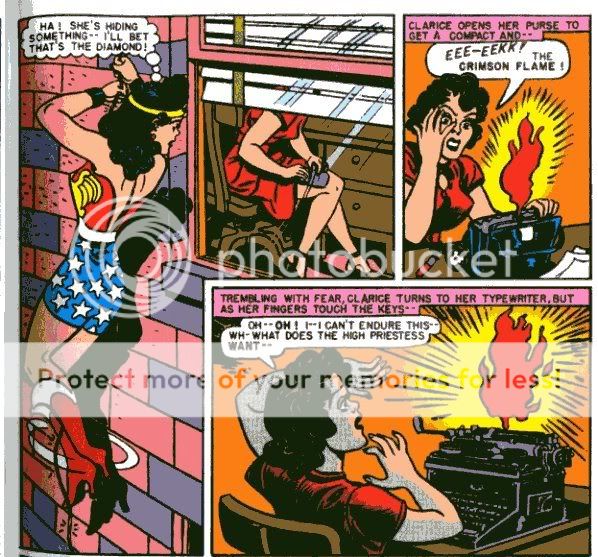
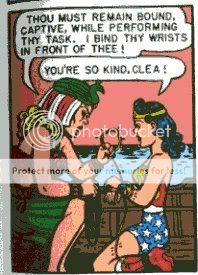
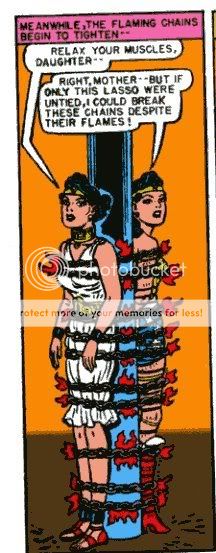

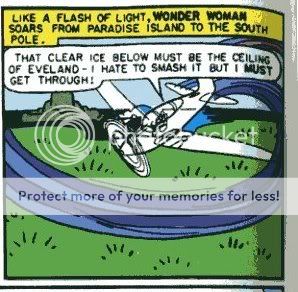
I do definitely like this art more than Ditko’s stuff on Spider-Man
Man, that’s just crazy. I mean, Jesus … Oh well, tastes differ I suppose.
The Les Daniels book on Wonder Woman is worth checking out for Peter info, and in general it’s quite a good history of the character. I think Men of Tomorrow also tells a bit about Peter, though not much more than Wikepedia.
One point I don’t remember and wish I could fill in:
why did her title stay in print all thru the superhero drought of the 1950s? DC’s policy seems to be that decades of continuous own-title publication guarantee a character icon status. That’s why Wonder Woman stays up there with Batman and Superman even though she sells more like Aquaman. So who was keeping her going all those years, was it boy readers or girl readers?
My guess: mainly boys but with a bigger than usual proportion of girls, enough to keep the title limping along when most other superheroes were dead in their tracks.
I’ve never been that into Ditko’s spider-man stuff. I certainly don’t hate it…but his work on Dr. Strange is the only stuff that ever really sent me.
I’ve heard a story, possibly apocryphal, that for arcane copyright reasons, DC needs to publish a Wonder Woman title or lose the rights. That could be complete nonsense, though.
I don’t know what else Peter did, but he is one of the artist Dan Nadel is featuring in his second Art Out of Time book. I assume that won’t be Wonder Woman material (doubt DC would give the rights).
I totally about liking Peter’s art more than Ditko’s.
You’re both nuts.
(Assuming that “agree” is supposed to go between “totally” and “about.”)
You should write a post on why you like Ditko, Tom. I’m curious, both in that I don’t have a firm grasp on what you look for in art, and in that I don’t know exactly what the case for Ditko as genius is supposed to be.
When is that Art Out of Time book supposed to appear, Derik. Do you know?
The answer to why WW stayed in print:
The original contract specified that if WW went out of print, the copyright would shift to Marston (or Moulton or whatever). Just as with Watchmen (wherein the original copyright was supposed to shift to Moore once the book went out of print), DC wanted to retain copyright and so ensured that WW never was out of print, even for a month…Even when they rebooted with George Perez, they made sure no months passed without WW on the stands in some fashion….
And, btw, you can learn alot about Jerry Siegel by reading the first couple years of Superman. (See Men of Tomorrow for some details on Siegel’s life that come up in fairly disturbing fashion in those issues–Shuster too)
I don’t doubt there’s personal stuff in Siegel’s Superman…but the personal content and the character aren’t so thoroughly interwoven that it’s impossible to separate them. Or so it seems to me, anyway….
And how much does DC suck? Let us count the ways….
It’s nice of you to think I could make a case, but art is a subject I keep quiet about. I’d have to think a long time before explaining why I liked any given artist. Right now I have to spend the time on other stuff.
But, really, you guys are lukewarm about Ditko and you like Peter? Well, it takes all kinds. Do you guys know of anyone else who feels the same way on either count?
The original contract specified that if WW went out of print, the copyright would shift to Marston (or Moulton or whatever).
Were they making money on the issue sales back in the 50s?
The Henry Darger comparison was brilliant– it completely encapsulated why I find Golden Age WW stories compelling, but in a way that leaves me feeling unsettled and a little ill after I finish reading one.
I think it’s safe to say that they were not making money on WW in the 50’s (or for much of her run, really)–but there’s always the possibility of big profits (as with the TV show) to keep the desire for maintaining rights in place.
Tom: Yeah, “agree” should have been in there.
Also I find it extremely odd you keep quiet about art… that’s integral to comics and talking about them, isn’t it?
Noah: Dan’s posted a bit about the book on the Comics Comics blog, but I don’t think it has a pub date yet.
I find Peter’s art oddly compelling. It’s stiff yet decorative (particularly when drawing foliage and clouds/smoke). His line work is really beautiful, it has a lot of variation in thickness and is rather woodcut like.
Not sure if he did the colors, but the really bright colors also add a wonderful element.
I’m going to have to write a post about the WW book I have. I don’t think I’ve ever read the whole thing, but I like just looking at it.
“Also I find it extremely odd you keep quiet about art… that’s integral to comics and talking about them, isn’t it?”
I guess “important” and not “integral,” since I can get around the subject often enough
Derik; yeah, the decorative element, and the weird stylization kills me. He has a really nice flair for layout as well, I think; it’s not flashy, but he pays attention to the look of the whole page.
There is a woodcut air to it as well; the panels all look like friezes.
Tom, I may try to post at some point about Ditko’s art; maybe I can poke you into responding if you have something to launch off of.
Alicia; I remember clearly the first time I saw Darger’s work. It was definitely a “holy shit!” kind of moment. But the more you learn about him, and the more you look at his stuff..”a little ill” is about right.
Hmm…I guess no one else wants to talk about the blatant and hidden sexual statements (or implications) in the WW comics. The legend of Wonder Woman has her coming from a land consisting entirely of women. The implication of lesbianism is a common male fantasy/turn-on. Plus there’s also a common (and, unfortunately, it’s still common even in these times) assumption that powerful women are lesbians. Maybe all that bondage of WW and her cohorts is partly a sexual fetish of Moulton and/or Peters, but maybe they want to show women’s power being restrained. And that written statement about happiness only being obedience to authority? Pretty blatant–no hidden message there. WW was created and written at the same time men returned from World War II to find women had replaced them in their factory jobs. Perhaps it was written partly in response to that?
The post is all about the blatant and hidden sexual statements. I talk about men looking at girls looking at girls as being fetishized…. I guess I didn’t quite say, “look! look! lesbianism!”…but it is pretty obvious.
Moulton is extremely explicit about wanting to use Wonder Woman as an icon to teach girls self-confidence and strength. I think to read it as *just* about disempowering women is getting only half the picture — just as saying it’s *just* about empowering women is only a half truth. I’ll try to talk somewhat more about this in the post tomorrow, hopefully….
Also, honestly, I haven’t totally thought through what exactly it is Moulton is doing. I think he’s definitely got a fetishistic investment in feminism. Part of that investment clearly involves the link between feminism and lesbianism; and part of it involves masochistic dominance fantasies, which run both ways (strong women dominating men; men dominating strong women.) I’d need to read more of the early stories than I have, and read more about Moulton himself, to be able to work through what he’s doing more clearly than that, though. Not sure I’ll ever find the time…but we’ll see….
As I recall, Men of Tomorrow has a paragraph or two that lay out the Marston philosophy. Something about men learning from women but what they have to learn is the strength that comes thru submission.
I think that Peter’s style was a little less outside the comic mainstream than it seems from our belated perspective. He’s obviously influenced by Lt. Dick Calkins, who drew the massively popular “Buck Rogers” strip in the 1930s. (You can check it out in the “Buck Rogers” hardcover collection that just came out.)
*Very* interesting. I’ll have to check it out.
Men of Tomorrow, I mean.